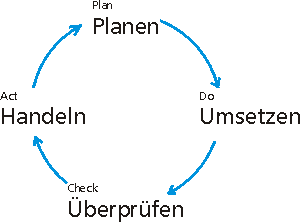Many companies do not consider waste, energy provision, water consumption, as well as the selection of resources and operating materials, etc. from an environmental point of view. They are merely regarded as a necessity in terms of production means.
But small changes can often bring ecological and economic advantages (such as the separate registration of various waste, energy and water savings...). By introducing an environmental management system, “environmental costs” can be reduced in the long-term.
In order to assist the development of an environmental management system, the most referred to standards are DIN EN ISO 14001 and Regulation (EC) No. 1221/2009 (EMAS III). Both directives contain the most important aspects to be considered in terms of a functioning environmental management system.
The development and implementation of such an environmental management system is carried out in accordance with a PDCA cycle:

- Plan
- Environmental aspects are identified and evaluated
- Environmental targets are defined based on environmental aspects and implemented by means of an environmental program.
- Do (Implementation, realisation)
- Development of an environmental structure
- Compiling and controlling environmental management documentation
- Implementation of procedures in terms of the monitoring of environmental processes and development of an emergency management system
- Check
- Measuring and monitoring environmental performance and the respective EMS
- Act
- Evaluating the EMS and identifying opportunities for improvement
When a company uses DIN EN ISO 14001 or EMAS III, it is able to ensure that an extensive as well as tried and tested management system has been implemented. By carrying out an external audit through a certification company the functioning of the implemented system may be confirmed by means of a certificate. In this way, clients, business partners and authorities can be assured that a recognised environmental management system has been implemented.
Regulation (EC) No. 1221/2009 (EMAS III) contains DIN EN ISO 14001 as part of its Annex II.


